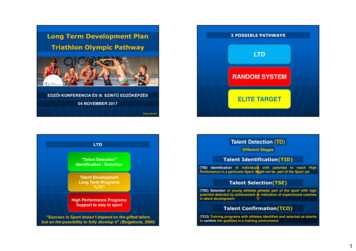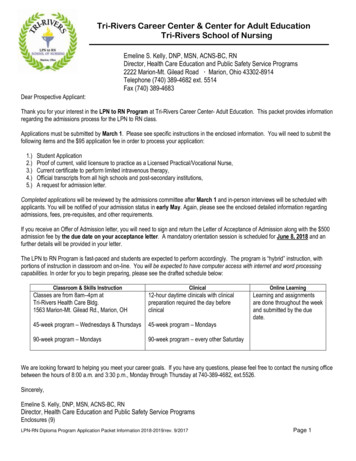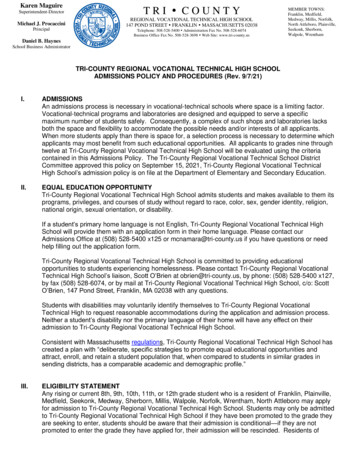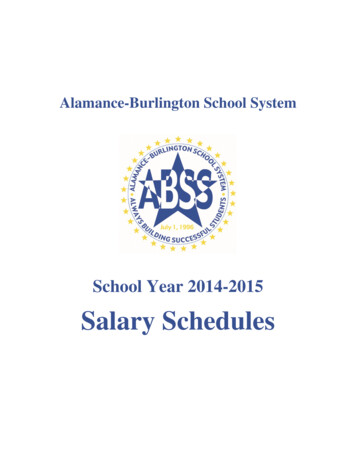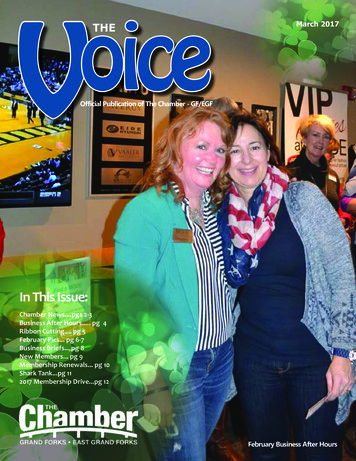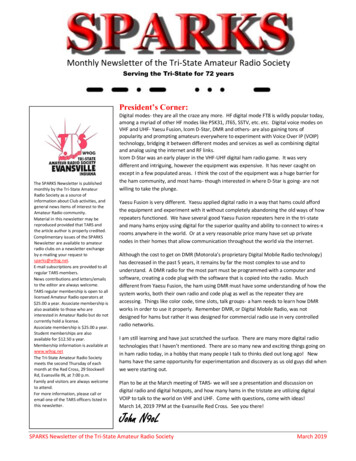
Transcription
Monthly Newsletter of the Tri-State Amateur Radio SocietyServing the Tri-State for 72 yearsPresident’s Corner:The SPARKS Newsletter is publishedmonthly by the Tri-State AmateurRadio Society as a source ofinformation about Club activities, andgeneral news items of interest to theAmateur Radio community.Material in this newsletter may bereproduced provided that TARS andthe article author is properly credited.Complimentary issues of the SPARKSNewsletter are available to amateurradio clubs on a newsletter exchangeby e-mailing your request tosparks@w9og.net.E-mail subscriptions are provided to allregular TARS members.News contributions and letters/emailsto the editor are always welcome.TARS regular membership is open to alllicensed Amateur Radio operators at 25.00 a year. Associate membership isalso available to those who areinterested in Amateur Radio but do notcurrently hold a license.Associate membership is 25.00 a year.Student memberships are alsoavailable for 12.50 a year.Membership information is available atwww.w9og.netThe Tri-State Amateur Radio Societymeets the second Thursday of eachmonth at the Red Cross, 29 StockwellRd, Evansville IN, at 7:00 p.m.Family and visitors are always welcometo attend.For more information, please call oremail one of the TARS officers listed inthis newsletter.Digital modes- they are all the craze any more. HF digital mode FT8 is wildly popular today,among a myriad of other HF modes like PSK31, JT65, SSTV, etc. etc. Digital voice modes onVHF and UHF- Yaesu Fusion, Icom D-Star, DMR and others- are also gaining tons ofpopularity and prompting amateurs everywhere to experiment with Voice Over IP (VOIP)technology, bridging it between different modes and services as well as combining digitaland analog using the internet and RF links.Icom D-Star was an early player in the VHF-UHF digital ham radio game. It was verydifferent and intriguing, however the equipment was expensive. It has never caught onexcept in a few populated areas. I think the cost of the equipment was a huge barrier forthe ham community, and most hams- though interested in where D-Star is going- are notwilling to take the plunge.Yaesu Fusion is very different. Yaesu applied digital radio in a way that hams could affordthe equipment and experiment with it without completely abandoning the old ways of howrepeaters functioned. We have several good Yaesu Fusion repeaters here in the tri-stateand many hams enjoy using digital for the superior quality and ability to connect to wires-xrooms anywhere in the world. Or at a very reasonable price many have set up privatenodes in their homes that allow communication throughout the world via the internet.Although the cost to get on DMR (Motorola’s proprietary Digital Mobile Radio technology)has decreased in the past 5 years, it remains by far the most complex to use and tounderstand. A DMR radio for the most part must be programmed with a computer andsoftware, creating a code plug with the software that is copied into the radio. Muchdifferent from Yaesu Fusion, the ham using DMR must have some understanding of how thesystem works, both their own radio and code plug as well as the repeater they areaccessing. Things like color code, time slots, talk groups- a ham needs to learn how DMRworks in order to use it properly. Remember DMR, or Digital Mobile Radio, was notdesigned for hams but rather it was designed for commercial radio use in very controlledradio networks.I am still learning and have just scratched the surface. There are many more digital radiotechnologies that I haven’t mentioned. There are so many new and exciting things going onin ham radio today, in a hobby that many people I talk to thinks died out long ago! Newhams have the same opportunity for experimentation and discovery as us old guys did whenwe were starting out.Plan to be at the March meeting of TARS- we will see a presentation and discussion ondigital radio and digital hotspots, and how many hams in the tristate are utilizing digitalVOIP to talk to the world on VHF and UHF. Come with questions, come with ideas!March 14, 2019 7PM at the Evansville Red Cross. See you there!John N9oLSPARKS Newsletter of the Tri-State Amateur Radio SocietyMarch 2019
Beyond the BaofengChris Lantaff, KE9YKLogging and the QSL.What is a log and why keep one?All hams used to be required to keep a station log detailingtheir station operations and contacts. Although the FCCeliminated that requirement in 1983 a station log is stillgood operating practice. An accurate log gives you a way toverify contacts, acknowledge received QSL cards and is likea personal record of people and places you have talked to.It can show whether or not your station was active duringcomplaints of RF interference. Years later it could be nice toreview your contacts and also analyze how your stationperformed using different antennas, configurations andequipment.Paper log books and log sheets are available from the ARRLand printable templates are available online that you canuse with a 3 ring binder.Computer logging. Quite a number of computer loggingprograms are available and after trying several over theyears I settled on ACLog with N3FJP suite. The price for thesimplicity of the software can’t be beat, in my opinion butmake sure to try a number of available programs and selectthe best to suit your needs.QSL’s, confirmation of contact, and the final courtesy.Ham radio has long been known for QSL cards.Sometime back in the early 1900’s when radio broadcastingwas first becoming popular, people would send receptionreports to radio stations hoping to get a letter replyverifying that they had heard the station. Many radioowners were proud of just how many distant stations theycould receive and the radio stations were glad to see justhow far there transmissions could be heard. This carriedover into the shortwave listening (SWL) community,amateur and even later to the Citizens Band radio craze ofthe 70’s. After a century of use it can still be one of the funparts of the hobby, although it seems that with the adventof things like LOTW, eQSL and QRZ Logbook, the QSL card iswaning. I am actually surprised by the poor confirmationresponse even on LOTW. I guess I am old school but a lot ofstations used to request qsl’s.I haven’t yet set up eQSL to show confirmed contactsbecause I was most interested in ARRL awards but I amgiving some thought to letting eQSL contacts show asconfirmed in my log also.QSL cards can be anything from simple to elaborate andthere are many QSL printers listed online.Later I will discuss using the ARRL QSL service for sendingand receiving DX QSL cards.Here is a recent FACEBOOK post from John N9OL.John C Van Vorst shared a link to thegroup: TriState Amateur Radio Society,Evansville Indiana.For computer logging I am an ACLog zealot.N3FJP wrote and sells ACLog for a reasonableprice and he is extremely responsive to userquestions and support issues. It is awesome.Check it out at n3fjp.comAlso, when portable I absolutely love HamLog.It is very inexpensive and available in theapp stores. I log portable in my phone withthis app that does so much more than log. Youmust check it out too.TARS has both paper logs and N3FJP computer loggingsoftware in the Red Cross radio room. TARS also uses N3FJPlogging software for Field Day and other contests.One advantage of software logging is the ability to interfacewith Logbook Of The World, LOTW and e-qsl with just a fewkeystrokes.SPARKS Newsletter of the Tri-State Amateur Radio SocietyMarch 2019
McCutchan AwardBRAG RAGCongratulations to Raymond Edge W9KHP the McCutchanaward winner for the year 2018. Raymond has been veryactive since getting his license, not only within TARS butalso Warrick Co ARES/RACES and the Alcoa radio club.Raymond was the energy and visionary stepping up as thefirst chairman of TARS new annual HAMTOBER Fest.The McCutchan Award reads:The strength and progress of Amateur Radio is vested inthe hearts and minds of dedicated Amateur RadioOperators who voluntarily give of their time andknowledge. John McCutchan, a dedicated Amateur RadioOperator was a leader in this respect and is honored by hisfriend Ellis Carson, who promoted and sponsored thisaward. By your dedication and your contributions you havegiven inspiration and leadership to others, and havebrought honor and dignity to your club and AmateurRadio.POTA AwardsCongratulations to John N9OL and Raymond W9KHP fortheir Platinum Hunter POTA awards.Club Code Key ContestThis contest is a just for fun event and will have certificatesawarded for various categories.Judging will happen in the time between the meetingprogram and the business meeting.A code oscillator will be set up to check the operation ofthe keys.The fun is starting in March with STRAIGHT KEYcompetition.The rules are very simple. You must have built the key YOURSELF.It may be a KIT or Homebrewed.It must WORK.Congratulations to Cory KD9MHB and Chris KE9YK on theirARISS SSTV reception report confirmations.The schedule is.March - Straight KeyMay - Paddle KeyJuly - Bug or Cootie KeySeptember - MacGyver Key*MacGyver key is taking any object and using the parts toturn it into a key with a minimum of tools.E.g. - an old toaster, ink pen or junk drawer hoard. I amsure you can come up with some piece of junk layingaround, use your imagination.Even if you don’t work CW, this can be a fun contest just toget everyone up and doing something. Perhaps we couldeven get a CW learning net on the air and put them to use.SPARKS Newsletter of the Tri-State Amateur Radio SocietyMarch 2019
ARISS SSTV receptions from Chris KE9YK using MSSTVsoftware with the computer microphone near the radiospeaker. I had over 20 receptions in total over the 2weekends. There were many reports of weak signals fromthe ISS for the first weekend and they were able to extendthe event for a second weekend.ARISS SSTV receptions by Cory KD9MBH using his cellphone over the radio speaker.SPARKS Newsletter of the Tri-State Amateur Radio SocietyMarch 2019
You never know who might be listeningAfter receiving the ARISS SSTV special event transmission, Isent out a transmission just for kicks in case someone elsehad set up also and might still be listening.This is what I found in an e-mail the next morning."geared to helping other radio amateurs and antennaenthusiasts discover what I have managed to uncover overthe years - and then to go well beyond."PROJECTSALTOID PHONE CHARGERHere is pix I received 2/9/2019 @ 0059Z.We have a digital net on Thursday evenings on Owensbororepeater 145.330 PL103.5 at about 9:45P. It follows thelocal ARES simplex net on 146.55. We start on the repeaterand the move to asimplex frequency toexchange SSTV picturesusually. This is veryinformal net with just afew guys. Maybe youcould drop by someThursday.73 de WB0NEXJimMark Thienes KC9TYAI started with an empty Altoids tin and cut a small hole, bigenough for the usb charger to fit in. The one I used was froma usb cigarette lighter car charger that I had disassembled.Since it will be using a 9 volt battery, I purchased a packageof two 9v Battery Snaps from Hutch and Son.I soldered the red plus wire to the spring which I hadshortened. Then I soldered the black - negative wire to thenegative contact which was a thin sheet of metal. I hadsome rubber caps that I put on the 9v battery end to keep itfrom shorting out while stored. When I tried the chargerout it showed my phone was charging when plugged in.This was a fun project, and I even got to eat candy in themeantime. This is something you could use in case of anEmergency when your phone dies.Just goes to show you never know who might be listening.Chris - KE9YKW4RNL is liveGood news for antenna builders and experimenters. Irecently came across a link while researching an antennaand found what appears to be a copy of the old htmlL. B. Cebik, W4RNL (SK), ARRL Technical Adviser andantenna authority, was known to many hams for thenumerous articles he wrote on antennas and antennamodeling. He had articles published in most of the US hamjournals, including QST, QEX, NCJ, CQ, CommunicationsQuarterly, Ham Radio, 73, QRP Quarterly, RadioElectronics and QRPp. Larry Wolfgang, WR1B, QEX Editor,called Cebik "probably the most widely published andoften read author of Amateur Radio antenna articles everto write on the subject."Cebik maintained a Web site, www.cebik.com, a virtualtreasure trove to anyone interested in antennas. Besides afew notes on the history of radio work and other bits thatCebik called "semi-technical oddities," the collectioncontains information of interest to radio amateurs andprofessionals interested in antennas, antenna modelingand related subjects, such as antenna tuners andimpedance matching. Cebik said that his notes wereSPARKS Newsletter of the Tri-State Amateur Radio SocietyMarch 2019
THE MYTH OF VHF LINE-OF-SIGHT8 FEBRUARY 2019 BOB K0NRWhen we teach our Technician License class, we normallydifferentiate between HF and VHF propagation by sayingthat HF often exhibits skywave propagation but VHF isnormally line-of-sight. For the beginner to ham radio, thisis a reasonable model for understanding the basics of radiopropagation. As George E. P. Box said, “All models arewrong, but some are useful.”In recent years, I’ve come to realize the limitations of thismodel and how it causes radio hams to miss out on what’spossible on the VHF and higher bands.Exotic Propagation ModesFirst, let me acknowledge and set aside some of the moreexotic propagation modes used on the VHF and higherbands. Sporadic-e propagation allows long distancecommunication by refracting signals off the e-layer of theionosphere. This is very common on the 6-meter band andless so on the 2-meter band. I like to think of this as theVHF bands trying to imitate HF. Tropospheric ductingsupports long distance VHF communication when ductsform between air masses of different temperatures andhumidities. Auroral propagation reflects the radio signaloff the auroral ionization that sometimes occurs in thepolar regions. Meteor scatter reflects signals off theionizing trail of meteors entering the earth’satmosphere. Earth-Moon-Earth (EME) operation bouncesVHF and UHF signals off the moon to communicate withother locations on earth. These are all interesting anduseful propagation mechanisms for VHF and higher but notthe focus of this article.Improved Line-of-Sight ModelNow let’s take a look at more “normal” VHF propagationthat occurs on a daily basis, starting with the simple lineof-sight propagation model. The usual description of lineof-sight VHF is that the radio waves travel a bit furtherthan the optical horizon (say 15% more) . Let’s refer to thisas the Line-of-Sight (LOS) region where signals are usuallydirect and strong. What is often overlooked is that beyondthe radio horizon, these signals continue to propagate butwith reduced signal level. Let’s call this the Non-Line-ofSight (NLOS) region. The key point is that the radio wavesdo not abruptly stop at the edge of the LOS region theykeep going into the NLOS region but with reduced signalSPARKS Newsletter of the Tri-State Amateur Radio Societystrength. Now I will admit that this is still a rather simplisticmodel. Perhaps too simplistic. I’m sure we could usecomputer modeling to be more descriptive and precise,but this model will be good enough for this article. Allmodels are wrong, but some are useful.WORKING the LOS and NLOS RegionsLet’s apply the model for Summits On The Air (SOTA) VHFactivations. If we are only interested in working the LOSregion, we won’t need much of a radio. Even a handheldtransceiver with a rubber duck antenna can probably makecontacts in the LOS region. It’s still worth upgrading therubber duck antenna to something that actually radiates toimprove our signal (such as a half-wave antenna). We maypick up some radio contacts in the NLOS region as well butour success will be limited.To improve our results in the NLOS zone, we need toincrease our signal strength. We are working on themargin, so every additional dB can make enoughdifference to go from “no contact” to “in the log.” Thinkabout another radio operator sitting in the NLOS zone butnot quite able to hear your signal. Your signal is just a bittoo weak and is just below the noise floor of the operator’sreceiver. Now imagine that you improve your signalstrength by 3 dB, which is just enough to get above thenoise and be a readable signal. You’ve just gone from “notreadable” to “just readable” with only a few dBimprovement.What can we do to improve our signal levels? The firstthing to try is improving the antenna, which helps you onboth transmit and receive. I already mentioned the need toditch the rubber duck on your HT. My measurementsindicate that a half-wave vertical is about 8 dB better thana typical rubber duck. This is only anestimate performance of rubber duck antennas varygreatly. A small yagi (3-element Arrow II yagi) can addanother 6 dB improvement over the half-wave antenna,which means a yagi has about a 14 dB advantage over arubber duck.On the other hand, if you believe that your VHF radio isonly Line-of-Sight, then there is no reason to work onincreasing its signal level. The radio wave is going to travelto anything within the radio horizon and then it willmagically stop. This is the myth that we need to break.More PowerWhen doing SOTA activations, I noticed that I was able tohear some stations quite well but they were having troublehearing me. Now why would this be? Over time, I startedto realize these stations were typically home or mobilestations running 40 or 50 watts of output. This created animbalance between the radiated signal from my 5Whandheld and their 50 watts. In decibels, this difference is10 dB. Within the LOS region, this probably is not going toMarch 2019
matter because signals are strong anyway. But when tryingto make more distant radio contracts into the NLOS zone,it definitely makes a difference. So I traded my HT for amini-mobile transceiver running 25W. See the completestory in Chapter: More Power For VHF SOTA.Weak Signal VHFOf course, this is nothing new for serious weak-signal VHFenthusiasts. They operate in the NLOS region all of thetime, squeezing out distance QSOs using CW, SSB and theWSJT modes. They generally use large directionalantennas, low noise preamps and RF power amplifiers toimprove their station’s performance. They know that a dBhere and a dB there adds up to bigger signals, longerdistances and more radio contacts. A well-equipped weaksignal VHF station in “flatland geography” can work over250 miles on a regular basis no exotic propagationrequired.Now you might think that FM behaves differently, becauseof the threshold effect. When FM signals get weak, theyfade into the noise quickly a rather steep cliff comparedto SSB which fades linearly. FM has poor weak-signalperformance AND it fades quickly with decreasing signalstrength. This is why it is not the favored modulation forserious VHF work. But the same principle applies: if we canboost our signal strength by a few dB, it can make thedifference between making the radio contact or not.So VHF is not limited to line-of-sight propagation thesignals go much further. But they do tend to be weak insignal strength so we need to optimize everything underour control to maximize our range.73, Bob K0NRMarch meeting ProgramThe March meeting program will be by Mike KC9BUHdiscussing digital radio. Mike has briefly discussed hismmdvm Pi-Star setup before and will have a more detailedpresentation this time.Here is a recent interesting blog post on the Pi STARhotspot from down t-gettingstarted.htmlSPARKS Newsletter of the Tri-State Amateur Radio SocietyAre You UP to a ChallengeDo You have what it takes to be TOP BULB?This is it: the ultimate challenge in ham radio.Announcing the 2019 Lightbulb QSO contest, March 9th20:00 UTC through March 10th 20:00 UTC.5 categories of competition HOUSEHOLDCOMMERCIAL/INDUSTRIALHOMEBREWDUMMY LOADFREESTYLEObjective: to build and use an antennaconstructed with a lightbulb as the main radiating elementand make as many CW, Phone, and Digital QSOs aspossible in a 24 hour period. Complete rules, details, andinformation on constructing and using a lightbulb as anantenna can be found rtyNew Plan Aligns ARES with the Needs ofServed AgenciesThe ARRL Letter for February 21, 2019The new ARES Plan adopted by the ARRL Board of Directorsat its Annual Meeting in January represents an effort toprovide ARES with a clearly defined mission, goals, andobjectives; specific trainingrequirements, and a systemfor consistent reporting andrecord-keeping. The Board'sPublic Service EnhancementWorking Group (PSEWG)spent more than 3 yearscrafting the ARES Plan which,ARRL officials believe,provides a much-neededupdate of the program's rolein public service and emergency preparedness in the 21stcentury. Concerns focused on bringing ARES into alignmentwith the National Incident Management System (NIMS)and Incident Command System (ICS), and creating moreconsistent and standardized ARES training requirements.March 2019
Vanderburgh Co. ARES/RACESWarrick County ARES/RACESThe next Vanderburgh countyARES/RACES meeting March 21st,7:00 pm at the Vand Co. WestSide EMA Training Center (WEMA)1430 Harmony Way.Anyone interested in emergencycommunication in VanderburghCounty is invited.Winter Field Day Winter field day was a joint event with the Ohio ValleyAmateur Radio Club. The event was located at the AlcoaClubhouse. The Auxcom trailer was set up and utilizedduring the contest. The trailer was manned and tested foroperation and capabilities. The new Generators operatedperfectly and the HF radio equipment brought into thetrailer by individuals connected as a plug and use units.The use of the trailer as it is currently can be used as adeployable unit. Its functionality improves with each use.The new ARES Connect volunteer management system isbeing activated in Indiana and provides many valuablefeatures that will truly enhance the experience ofemergency communication volunteers. Features include: arobust event management feature that allows for events,register users, log hours; and a more automated reportingsystem based on user input. It can generate reports basedon the events users register and log hours for; enhancedroster management capabilities; and embeddedcommunications tools that will allow email and textmessages to volunteers.All ARES members should register at:http://vhub.at/aresconnect-inOn March 2nd we held a workday at WEMA with N9QVQ,WB9YIG, KC9TYA and KE9YK showing up to set up 2 newcomputers for outpost packet messenger, networked intothe BPQ system located in our radio room at WEMA. FLDigiwas also installed but has not yet been tested.The I-Gate receiver coax was replaced, re-routed and the IGate PI computer was mounted.We were also able to get the computers networked to theprinter in the radio room.Chris Lantaff KE9YKVanderburgh Co RACES Officerin82races@gmail.com c: 812.453.1972Monthly Meeting Standard Operating Guidelines: The majority of theFebruary meeting was spent reviewing the StandardOperating Guidelines for the Warrick County Aries/RacesGroup. During the review several items were identified asneeding to be updated and added. During the reviewseveral sidebar discussions took place concerningdeployment, Net Control, who initiates activation, how it iscommunicated, and the use of Spontaneous UnaffiliatedVolunteers. Discussions also included the use of multipleforms, where to find them and the importance of a goodpaper trail. Steve Connaughton Has made the revisions tothe documentation and distributed it to the members ofthe Warrick County Aries/Races Group via email. If youhave not received it contact Steve (sconnaug@gmail.com)or myself (KC9CLO@gmail.com) to get a copy.Auxcom Trailer: Several items still need to be completedon the Auxcom trailer. Most of the work will involve wireterminations and non-critical jobs to make the trailer morefunctional. The exterior of the trailer needs to be buffedand new decals put in place. The solar panel for the trailerneeds to be mounted and wired into the trailer. Some ofthe work will need to be completed during warmerweather. A lot of the smaller items such as wireterminations can be done any time. If anyone wants towork on the trailer contact Steve (sconnaug@gmail.com)to make arrangements to get into the trailer.Chris L Owen (KC9CLO)Public Information OfficerWarrick County ARES/RACES groupSPARKS Newsletter of the Tri-State Amateur Radio SocietyMarch 2019
Tri-State Emergency Net8:00 p.m. Wednesday nights on 146.79 pl 88.5If you haven’t checked into the Tri-State Emergency Net,please take a few minutes at 8:00 p.m. Wednesday eveningson 146.79 and get updated on what is happening, the latestclub information, calendar of upcoming events, topics ofgeneral interest and from time to time good old-fashionedrag chewing.Net Operator KC9TYAKE9YKKC9UVGN9QVQAprilThe 2019 Thunderstorm/Tornado season is just around thecorner, remember to monitor the weather net on the TARS146.79 repeater anytime there is a severe weatherwatch/warning issued from the Paducah NWS forVanderburgh or surrounding counties.Anytime severe weather is anticipated we try to have astand-by net up and once a warning or severe weather isreported we go into a SKYWARN net and relay weatherreports to the NWS in Paducah.SKYWARN Spotter training is scheduled forEvansville at 6:00 pm on March 12th at the RedCross. You must register online to attend.2019 NWS SKYWARN Spotter TrainingEat'n Before the Meet'nMarch 14th Eating Before the Meeting will be at PennStation East Coast Subs, 137 N Burkhardt Rd, in the stripsouth of WalMart. Their menu features an array of mouthwatering Grilled Penn Station submarine sandwiches,fresh-cut fries and hand-squeezed lemonade.Drop by for food, socializing, "story tell'n" and whateverelse comes to mind.Join the group at 5:30, or whenever you can make it. Checkin on 146.79 if you need directions or just bored on yourdrive in. Everyone is welcome to join us.If you have any suggestions on where you would like for usto meet,contact: Herb Alvey KB9MZH c:812.499.3729SPARKS Newsletter of the Tri-State Amateur Radio SocietyRegistration must be completed on-line to attend ngMarch 2019
March BirthdaysRob FurgusonKeith HemenwayDan KelleyJay KingRobert PointerJenny WashburneKD9KLI4thKB9WAC 6thN9WJ24thWB9ICL26thN9XAW2ndKC9NPA 10thIf your birthday isn’t listed please make sure we have it on fileby filling out the membership application when renewing.This also helps to make sure we have your current contactinformation.VE Testing2019 ScheduleJan 26Mar No TESTMay 25Jul 27Sep 28Nov No TESTFeb 23Apr 27Jun 29Aug 31Oct 26Dec 28All examinations will beadministeredattheAmerican Red Cross, Evansville Chapter, located at 29 S.Stockwell Road, Evansville Indiana 47714. Examinations willstart at 9:00 AM Central time.We have no pre-registration, and examinations areadministered on a walk-in basis.All the details can be found at:http://w9og.net/ve-testingFor more info contact:John VanVorst N9OL c: 812.305.4100TARS Second Annual Hamtober FestSaturday October 26th 2019, 7am - NoonLynnville Community CenterWatch for more info coming soon.Contact: hamfest@w9og.netWeb page: www.hamtoberfest.comSecretary ReportSecretary reports were attached as a separate PDF files.David Sandine KC9UVGTARS SecretaryTreasurer ReportBudget:January 2019 (prepared 1/31/2019)Opening Balance: 3,959.33Receipts:Memberships (including extra donations) 472.50Banquet Reservations 403.00Net Income from Auction 286.35Project Donation Bucket 85.00VE Room Rental 21.00ARRL Membership RetainedCommission for KD9LWC 15.00Total Receipts --- 1,282.85Expenditures:Total Expenditures--- Ending BalanceRed Cross Fund 0.00 5,242.18 1,087.82Jeff Holt AA9WJTARS TreasurerSPARKS Newsletter of the Tri-State Amateur Radio SocietyMarch 2019
Looking Ahead2019Straight Key Night Jan 1ARRL Kids Day JanWinter Field Day January 26/27TARS Banquet Feb 7INQP May 4 - 5MUSEUM SHIPS WEEKEND JuneARRL Kids Day JuneField Day June 22-2313 Colonies Special Event Jul 1-Jul 8, 1300Z-0400ZNational Night Out Aug 6International Lighthouse and Lightship Weekend (ILLW)Third full weekend of August 16-17Route 66 Special Event September 7-15Jamboree-on-the-Air Third full weekend in OctoberSKYWARN Recognition Day Dec 7 2019Your input is important.Sparks is YOUR information source for club activities andlocal Amateur radio information.In each issue we ask for submissions from club members.Tell us about your station, projects you have made or aremaking, anything interesting the TARS membership mightbe interested in.Submission deadline is the 25th of the month.Most any document format is acceptable.Photos or graphics of your subject are welcome.Send your article to: sparks@w9og.netSPARKS Newsletter of the Tri-State Amateur Radio SocietyTARS is an ARRL affiliated clubARRL Indiana SectionSection Manager: Jimmy Merry KC9RPXkc9rpx@arrl.netTARS mailing address:TARSP.O. Box 4521Evansville, IN 47724Don’t forget to check out our web page www.w9og.netFacebook Grouphttps://www.facebook.com/groups/TARSw9ogTARS E-mail: info@w9og.net2019 Club Officers - Board membersPresident John VanVorst N9OLVice President Max Wilkinson KD9ABTTreasurer Jeff Holt AA9WJSecretary Dave Sandine KC9UVGBoard of DirectorsMark Thienes KC9TYA (2018-2019)Len Schmitt N9QVQ (2018-2019)Herb Alvey KB9MZH (2019)Rick Jackson K9EXY (2019-2020)Dennis Martin WA2USA (2019-2020)Mike Townsend W9KXP (2019-2020)SPARKS Editor:Chris Lantaff KE9YKE-mail: sparks@w9og.netMarch 2019
TARS has both paper logs and N3FJP computer logging software in the Red Cross radio room. TARS also uses N3FJP logging software for Field Day and other contests. One advantage of software logging is the ability to interface with Logbook Of The World, LOTW and e-qsl with just a few keystrokes.


